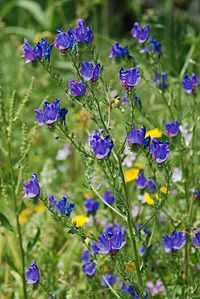
The in vitro genotoxicity potency of mixtures of pyrrolizidine alkaloids can be explained by dose addition of the individual mixture components
Sign Up to like & getrecommendations! Published in 2022 at "Environmental and Molecular Mutagenesis"
DOI: 10.1002/em.22512
Abstract: Plant‐based 1,2‐unsaturated Pyrrolizidine Alkaloids (PAs) are responsible for liver genotoxicity/carcinogenicity following metabolic activation, making them a relevant concern for safety assessment. Due to 21st century toxicology approaches, risk of PAs can be better discerned though… read more here.
Keywords: potency; vitro genotoxicity; genotoxic potency; genotoxicity potency ... See more keywords

Molecularly imprinted polymers-solid phase microextraction coupled with ultra-high performance liquid chromatography-tandem mass spectrometry for rapid analysis of pyrrolizidine alkaloids in herbal medicine.
Sign Up to like & getrecommendations! Published in 2019 at "Journal of separation science"
DOI: 10.1002/jssc.201900665
Abstract: Pyrrolizidine alkaloids are reported as the most widely distributed natural toxins and pyrrolizidine alkaloid-containing herbal medicines are probably the most common poisonous plants affecting humans. We reported pyrrolizidine alkaloid-molecularly imprinted polymers-solid phase microextraction for the… read more here.
Keywords: medicine; pyrrolizidine alkaloids; polymers solid; molecularly imprinted ... See more keywords

Production of pyrrolizidine alkaloids and shikonins in Echium plantagineum L. in response to various plant stressors.
Sign Up to like & getrecommendations! Published in 2019 at "Pest management science"
DOI: 10.1002/ps.5540
Abstract: BACKGROUND Echium plantagineum a native of Europe and Africa, is a noxious invasive weed in Australia forming monocultural stands in pastures and rangelands. It produces a complex mixture of bioactive secondary metabolites including toxic pyrrolizidine… read more here.
Keywords: production; plant; echium plantagineum; plantagineum ... See more keywords

In vitro biotransformation of pyrrolizidine alkaloids in different species. Part I: Microsomal degradation
Sign Up to like & getrecommendations! Published in 2017 at "Archives of Toxicology"
DOI: 10.1007/s00204-017-2114-7
Abstract: Pyrrolizidine alkaloids (PA) are secondary metabolites of certain flowering plants. The ingestion of PAs may result in acute and chronic effects in man and livestock with hepatotoxicity, mutagenicity, and carcinogenicity being identified as predominant effects.… read more here.
Keywords: degradation; pyrrolizidine; pyrrolizidine alkaloids; alkaloids different ... See more keywords

Two New Pairs of Epimeric Pyrrolizidine Alkaloids from Liparis nervosa
Sign Up to like & getrecommendations! Published in 2019 at "Chemistry of Natural Compounds"
DOI: 10.1007/s10600-019-02673-z
Abstract: Two new pairs of epimeric pyrrolizidine alkaloids, nervosine XVI/XVII and XVIII/XIX were isolated from the whole plant of Liparis nervosa. Their structures were elucidated by extensive spectroscopic analyses including 1D, 2D NMR, and HR-ESI-MS. read more here.
Keywords: epimeric pyrrolizidine; two new; new pairs; pairs epimeric ... See more keywords

High abundance of pyrrolizidine alkaloids in bee pollen collected in July 2019 from Southern Germany
Sign Up to like & getrecommendations! Published in 2022 at "Environmental Monitoring and Assessment"
DOI: 10.1007/s10661-022-09907-8
Abstract: Pyrrolizidine alkaloids (PA) are secondary plant defense compounds and known pre-toxins when containing a 1,2-double bond. They are commonly produced by various plants and may thus be present in bee pollen which may be consumed… read more here.
Keywords: southern germany; pyrrolizidine alkaloids; pollen; july 2019 ... See more keywords

Survey of pyrrolizidine alkaloids in the tribe Lithospermeae (Boraginaceae) from Pan-Himalaya and their chemotaxonomic significance
Sign Up to like & getrecommendations! Published in 2018 at "Biochemical Systematics and Ecology"
DOI: 10.1016/j.bse.2018.09.002
Abstract: Abstract Family Boraginaceae has drawn the attention of many botanists for many years because of its systematic position and the presence of toxic pyrrolizidine alkaloids (PAs). Some researcher used these alkaloids as chemotaxonomic markers at… read more here.
Keywords: tribe lithospermeae; echimidine; chemotaxonomic significance; pyrrolizidine alkaloids ... See more keywords

Toxic pyrrolizidine alkaloids in herbal medicines commonly used in Ghana.
Sign Up to like & getrecommendations! Published in 2017 at "Journal of ethnopharmacology"
DOI: 10.1016/j.jep.2017.03.008
Abstract: ETHNOPHARMACOLOGICAL RELEVANCE Herbal medicines have been used for centuries for the management and treatment of various ailments due to the belief that they pose only little or no health risk and side effects, and also,… read more here.
Keywords: toxic pyrrolizidine; pyrrolizidine alkaloids; herbal medicines; medicines commonly ... See more keywords

Dietary alcohol exacerbates the hepatotoxicity induced by pyrrolizidine alkaloids: Hazard from food contamination.
Sign Up to like & getrecommendations! Published in 2021 at "Journal of hazardous materials"
DOI: 10.1016/j.jhazmat.2021.127706
Abstract: Pyrrolizidine alkaloids (PAs) are the most common plant-derived toxins with emerging evidence to contaminate soil, water, nearby plants and derived food products. Outbreaks of human poisoning cases, due to the ingestion of PA-contaminated food, have… read more here.
Keywords: dietary alcohol; contamination; hepatotoxicity; food ... See more keywords

Benzofurans, benzoic acid derivatives, diterpenes and pyrrolizidine alkaloids from Peruvian Senecio
Sign Up to like & getrecommendations! Published in 2018 at "Phytochemistry Letters"
DOI: 10.1016/j.phytol.2018.07.002
Abstract: Abstract Sixteen compounds incluiding four benzofurans (1–4), three benzoic acid derivatives (6–8), one eremophilane (9), four diterpenes (10–13) and four pyrrolizidine alkaloids (14–17) were isolated from Senecio subcandidus, S. klugii and S. ayapatensis from Peru.… read more here.
Keywords: pyrrolizidine alkaloids; diterpenes pyrrolizidine; benzoic acid; acid derivatives ... See more keywords

The Risk of Pyrrolizidine Alkaloids in Human Food and Animal Feed.
Sign Up to like & getrecommendations! Published in 2017 at "Trends in plant science"
DOI: 10.1016/j.tplants.2017.01.002
Abstract: Toxicity from naturally occurring plant pyrrolizidine alkaloids bears substantial risk to humans and livestock. Risk management strategies must focus on minimizing the likelihood of such alkaloids entering into the food chain. To address this challenge,… read more here.
Keywords: risk; risk pyrrolizidine; alkaloids human; food ... See more keywords